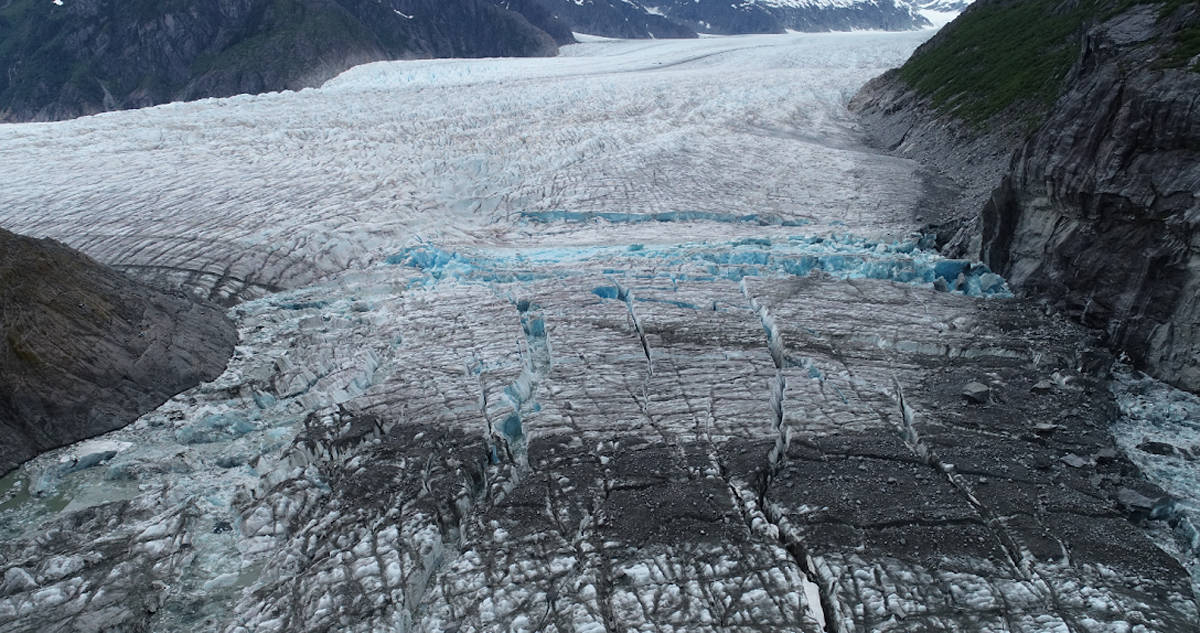The National Weather Service office in Juneau has canceled a flood watch for the Mendenhall River after the Mendenhall Glacier calved ice into Suicide Basin.
The basin, uphill from the face of the glacier, contains meltwater that surges into a jökulhlaup flood each summer. On Monday, an abrupt change in the basin’s water level seemed to indicate another flood was imminent. Upon further analysis, hydrologists and glacier experts found ice had broken free from the glacier and was floating in the basin, sloshing the water within.
Rick Fritsch, lead forecaster at the Weather Service here, said it was akin to “dropping a large chunk of ice into a bathtub.”
Eran Hood, a glaciologist at the University of Alaska Southeast, said it was quite a bit more spectacular than that. Hood was among a group of scientists who were at the spot when the glacier calved into the basin. Hood estimates a chunk of ice a fifth of a mile wide splashed into the basin with a cacophanous roar.
“It was tremendously loud. It sounded like explosions were going off,” he said.
Shards of ice flew into the air, icebergs overturned in the basin, and free-floating ice soon covered much of the basin’s surface.
“It was really, really impressive,” Hood said. “We have never seen any calving event that was this big in this section.”
Pictures show a fresh blue gash where dense glacial ice has been exposed to the air.
We are working with glacial experts from @uasoutheast and @USGS on glacial dam forecasting for #Juneau. Here is a clip of drone footage shot by Christian Kienholz from UAS of #Juneau's Suicide Basin shortly after Monday's likely calving event. #akwx @KTOOpubmedia @JuneauEmpire pic.twitter.com/S6Eab9w6bY
— NWS Juneau (@NWSJuneau) June 26, 2018
“You see these giant new ice cliffs forming where the ice just snaps off and drops into the water,” Hood said.
U.S. Geological Survey hydrologist Jamie Pierce was with Hood.
“Most of us were just at a loss of words. We weren’t expecting what we saw. It defied reason,” Pierce said.
At his office in Juneau, Fritsch said that despite the icy events uphill, “it’s pretty obvious that whatever happened in Suicide Basin has not had any kind of effect (on lake and river levels).”
With that in mind, the Weather Service canceled a flood watch that had been issued Monday afternoon.
Suicide Basin is not wholly understood, Hood said, but studies are under way to determine its dimensions, activity, and the threat it poses to the Mendenhall Valley.
Starting in 2011, the basin began collecting and releasing surges of water beneath the glacier and into Mendenhall Lake and Mendenhall River. The floods associated with releases in 2016 were the largest on records that began more than 50 years before.
The basin is like a bowl with an opening on its bottom. That exit is normally sealed with ice, allowing meltwater to collect within. When the weight of the water is too great for the icy seal, it lets loose, sending a surge of water beneath the glacier. It isn’t known how much water the basin can hold.
Monday’s event involved an unsupported ledge of ice that jutted over the edge of the bowl and down into the basin, below the surface of the water. Ice naturally floats, and when the buoyant pressure lifting the ice overcame the strength of the ice holding it, the ledge calved into the basin.
Hood said the ice entering the basin is a lobe separate from the main flow of the Mendenhall Glacier. He doesn’t think this week’s calving increases the flood risk to the Mendenhall Valley, but he acknowledged that the situation is complicated.
As ice fragments, it becomes more prone to melting, thus increasing the water in the basin. At the same time, the thinning Mendenhall Glacier is weaker and less able to hold water within the basin.
“It’s something we’re actively working on,” he said. “The university and USGS are still working together to monitor it and be able to better forecast the floods.”
Pierce said the next 12 hours should be revealing. Monday’s calving was such a significant event, it should have broken the icy seal that keeps water in the basin. That doesn’t appear to have happened.
“It’s re-sealed itself, and if we see (the water level) go back up again, we will have never seen that before,” he said.
If the water level does rise, that might indicate a firmer seal on the basin, something that would increase the flood danger for the Mendenhall Valley.
• Contact reporter James Brooks at jbrooks@juneauempire.com or 523-2258.

